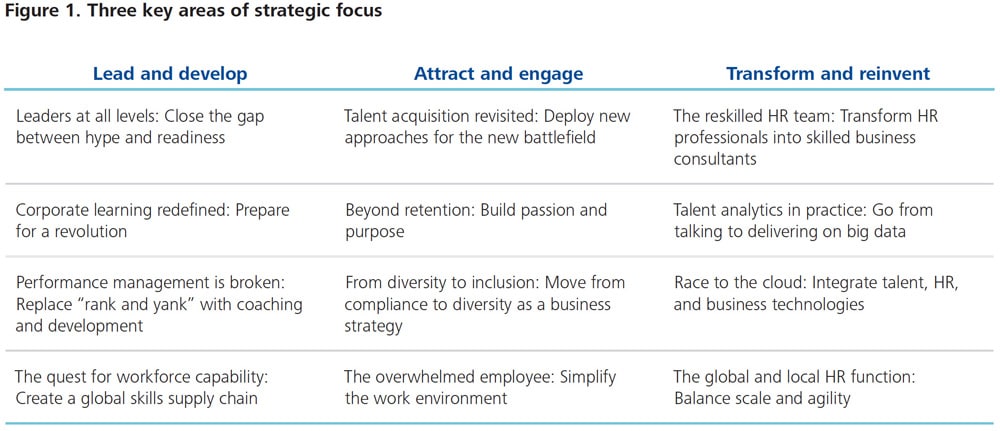Introduction has been saved

Introduction Global Human Capital Trends 2014
08 March 2014
CEOs and HR leaders see talent as a major challenge to growth. Where should you focus? Our survey of 2,500+ respondents in 90+ countries reveals 12 critical trends shaping the human capital agenda.
Explore the report findings
Launch the interactive trends dashboardCreate and download a custom PDF of the Human Capital Trends 2014 report.
As we begin 2014, global organizations have left the recession in the rear-view mirror and are positioning themselves aggressively for growth. Sluggishness has given way to expansion. Retrenchment has been replaced by investment. The need for caution has been superseded by the need to take action.
Yet as the economic recovery takes hold, businesses realize that the workforce today has changed. Skills are scarce, workers have high expectations, and Millennials are now in charge. Enter the 21st-century workforce.
The 21st-century workforce is global, highly connected, technology-savvy, and demanding. Its employees are youthful, ambitious, and filled with passion and purpose. Millennials are a major force—but so are older workers, who remain engaged and valuable contributors. Critical new skills are scarce—and their uneven distribution around the world is forcing companies to develop innovative new ways to find people, develop capabilities, and share expertise.
Critical new skills are scarce—and their uneven distribution around the world is forcing companies to develop innovative new ways to find people, develop capabilities, and share expertise.
Awakening to a new world: After the Great Recession
Future observers may look back at 2014 as a turning point: the time when the global recession ended and businesses put plans in place for a new wave of growth. But as this growth begins, companies are finding that they are dealing with a workforce with different demographics, different demands, and different expectations.
The world is much more global and interdependent
Globalization is a key theme in our research. In 2013, the developing countries contributed 50 percent of the world’s GDP.1 This is expected to grow to 55 percent by 2018, a significant increase in business opportunity centering on these newer economies.2 And these countries now have a large buying segment: The global middle class is expected to increase from 1.8 billion in 2009 to 3.2 billion in 2020, with Asia’s middle class tripling in size to 1.7 billion by 2020.3
Trends in leadership, talent acquisition, capability development, analytics, and HR transformation are all impacted by globalization. Companies that learn to leverage global talent markets while localizing their HR strategies will be poised for strong performance.
Mobile, social, and cloud computing continue to explode
Technology has transformed the workplace. At the start of 2008, there were only 3 million Apple iPhone® mobile devices in the world.4 At the end of 2013, according to a Gartner estimate, there were 1 billion smartphones and more than 420 million iPhone mobile devices shipped.5 Facebook had a million users in 2004, 100 million users in 2008, and an estimated 1.23 billion registered users today.6 And according to Forrester estimates, cloud computing will grow from a $41 billion business in 2011 to a $241 billion business by 2020.7
All this technology has transformed the world of recruiting, the world of education and training, the world of analytics, and even the way we work. Today we are online 24/7 and relentlessly flooded with information, messages, and communications.
Not only has technology become a critical and pivotal part of human resources, but we have also identified a new human capital issue discussed in this report: the overwhelmed employee. Organizations face an imperative to find ways to absorb more technology while simultaneously making it simple.
Demographic shifts are creating a diverse, multi-generational workforce
As the world’s population grows, the global workforce is getting younger, older, and more urbanized. Millennials are entering the workforce in greater numbers and reshaping the talent markets with new expectations. They are projected to make up 75 percent of the global workforce by 2025, and they are letting us know that they are ready to take the lead . . . soon.8 But as new research shows, Millennials want to be creative. They want to run their own businesses. They want accelerated career growth. In the words of one manager: “They don’t want a career, they want an experience.”9
Baby Boomers, although some started to retire in 2008, are refusing to leave their field. For both financial reasons and reasons of professional satisfaction, many are extending their working lives—benefiting from the incredible longevity dividend shared the world over.
These two trends are producing the most multi-generational workforce in history. How can companies manage this highly diverse set of employees when their needs vary widely? How can organizations change their strategy for performance management to address these new workforce dynamics?
Global social, political, and regulatory shifts are changing the focus of business
Employee engagement and retention are directly related to the social fabric of business. In the fall of 2011, we witnessed the Occupy Wall Street movement, starting in New York and spreading around the world. The boundaries between business and social issues are blurring as corporate social responsibility and “conscious capitalism” reshape business and talent markets. Consumer and talent markets are making new demands on businesses, with social and community concerns rising to new levels of priority. Regulation, particularly in the financial markets, continues to grow as the role of regulators continues to expand.
How can companies cultivate an ethos of mission, purpose, and conscious capitalism to attract and engage a workforce highly aware of these issues?
Technology is changing how we work and the skills we need
Finally, technology has changed the nature of collaboration, expertise sharing, and the skills one needs to succeed. Collaborative technologies continue to make it possible for teams to work in remote locations across the world, easily accessing experts within and outside the organization. Machine learning and artificial intelligence are disrupting one wave of workers and opening new career opportunities in analytics, machine-assisted manufacturing, and the service industries.10 The skills we need today and in the future are dramatically different than what they were only five years ago.
2014: A time for action
These changes in the workforce and workplace are significant, disruptive, and here today. How can human capital strategies power companies to thrive in this era of rapid change?
Our research shows a significant gap between the urgency of the talent and leadership issues leaders face today and their organizations’ readiness to respond. On every critical issue—leadership, retention and engagement, learning and development, analytics— executives recognize the need to take action, but express reservations about their team’s ability to deliver results.
One of the most important takeaways from this research is the fact that doing more is not enough. Today companies have to manage people differently – creating an imperative to innovate, transform, and reengineer human capital practices.
The 2014 Global Human Capital Trends report, developed after months of extensive global research, provides guidance and recommendations for these important strategies.
Three key areas of strategic focus
This year’s 12 critical human capital trends are organized into three broad areas:
- Lead and develop: The need to broaden, deepen, and accelerate leadership development at all levels; build global workforce capabilities; re-energize corporate learning by putting employees in charge; and fix performance management
- Attract and engage: The need to develop innovative ways to attract, source, recruit, and access talent; drive passion and engagement in the workforce; use diversity and inclusion as a business strategy; and find ways to help the overwhelmed employee deal with the flood of information and distractions in the workplace
- Transform and reinvent: The need to create a global HR platform that is robust and flexible enough to adapt to local needs; reskill HR teams; take advantage of cloud-based HR technology; and implement HR data analytics to achieve business goals
One of the largest global human capital surveys
When we set out to identify the top 12 global business challenges in talent management, leadership, and HR, we drew upon more than 15 years of research to examine the range of issues and the most effective solutions in the market. We also surveyed 2,532 business and HR leaders in 94 countries around the world, making it one of the largest global surveys of its kind.
This year, recognizing that global trends vary by a company’s size, location, and growth rate, we are not only publishing our global perspectives, but also giving you access to our data so you can draw your own conclusions. In the spirit of big data and analytics, we have created an interactive tool, the Human Capital Trends Dashboard, that allows you to drill into our survey data, investigate what it means, and apply it to your industry, your geography, and your company size.
Taking the next step
The goal of this research is to give executives insight and perspective, while identifying solutions to help them set priorities for the coming year. We remain convinced that some of the biggest opportunities for companies to improve growth, innovation, and performance center squarely on how business leaders reimagine, reinvent, and reinvigorate human capital strategies—informed by a deeper understanding of the new 21st-century workforce.
We look forward to hearing from you as you dive into this report and reflect on what it means for your organization.
Explore the Human Capital Trends Dashboard at http://www.deloitte.com/hcdashboard.





